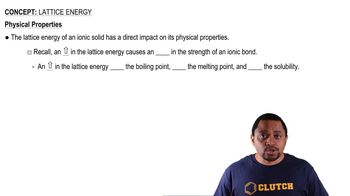Consider the lattice energies of the following Group 2A compounds: BeH2, 3205 kJ/mol; MgH2, 2791 kJ/mol; CaH2, 2410 kJ/mol; SrH2, 2250 kJ/mol; BaH2, 2121 kJ/mol. (a) What is the oxidation number of H in these compounds?
Ch.8 - Basic Concepts of Chemical Bonding
Chapter 8, Problem 83
A metal oxide has a lattice energy in the range of 3300 kJ/mol. Is the charge on the metal ion M likely to be 1+, 2+, or 3+? Explain.
 Verified step by step guidance
Verified step by step guidance1
Step 1: Understand the concept of lattice energy. Lattice energy is the energy required to separate one mole of an ionic solid into its gaseous ions. It is influenced by the charges on the ions and the distance between them.
Step 2: Recall the relationship between lattice energy and ionic charge. Lattice energy increases with the magnitude of the charge on the ions. Higher charges result in stronger electrostatic attractions, leading to higher lattice energies.
Step 3: Consider the typical lattice energy values for different charges. Generally, compounds with 1+ and 1- charges have lower lattice energies, while those with 2+ and 2- charges have higher lattice energies. Compounds with 3+ and 3- charges have even higher lattice energies.
Step 4: Compare the given lattice energy with typical values. A lattice energy of 3300 kJ/mol is relatively high, suggesting that the metal ion likely has a higher charge, such as 2+ or 3+.
Step 5: Conclude based on the comparison. Given the high lattice energy, it is more likely that the metal ion M has a charge of 2+ or 3+, as these charges correspond to stronger ionic interactions and higher lattice energies.
Key Concepts
Here are the essential concepts you must grasp in order to answer the question correctly.
Lattice Energy
Lattice energy is the amount of energy released when gaseous ions combine to form an ionic solid. It is a measure of the strength of the forces between the ions in an ionic compound. Higher lattice energy indicates stronger ionic bonds, which typically results from higher charges on the ions and smaller ionic radii.
Recommended video:
Guided course

Lattice Energy
Ionic Charge
The charge on an ion is determined by the number of electrons lost or gained by an atom. In metals, a higher positive charge (e.g., 2+ or 3+) usually corresponds to the loss of more electrons. The charge affects the lattice energy; ions with higher charges lead to stronger electrostatic attractions, resulting in higher lattice energies.
Recommended video:
Guided course

Formal Charge
Trends in Lattice Energy
Lattice energy trends can be predicted based on the charges and sizes of the ions involved. Generally, as the charge on the ions increases, the lattice energy increases due to stronger attractions. Conversely, larger ionic radii decrease lattice energy because the distance between the ions increases, weakening the electrostatic forces.
Recommended video:
Guided course

Lattice Energy
Related Practice
Textbook Question
Textbook Question
The ionic compound CaO crystallizes with the same structure as sodium chloride (Figure 8.3). (a) In this structure, how many O2- are in contact with each Ca2+ ion (Hint: Remember the pattern of ions shown in Figure 8.3 repeats over and over again in all three directions.)
Textbook Question
Construct a Born–Haber cycle for the formation of the hypothetical compound NaCl2, where the sodium ion has a 2+ charge (the second ionization energy for sodium is given in Table 7.2). (a) How large would the lattice energy need to be for the formation of NaCl2 to be exothermic?
